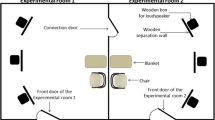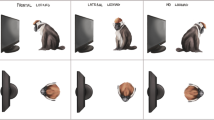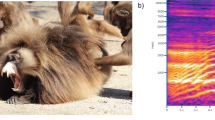Abstract
Most vertebrates yawn in situations ranging from relaxation to tension, but only humans and other primate species that show mental state attribution skills have been convincingly shown to display yawn contagion. Whether complex forms of empathy are necessary for yawn contagion to occur is still unclear. As empathy is a phylogenetically continuous trait, simple forms of empathy, such as emotional contagion, might be sufficient for non-primate species to show contagious yawning. In this study, we exposed pairs of male rats, which were selected for high yawning, with each other through a perforated wall and found that olfactory cues stimulated yawning, whereas visual cues inhibited it. Unexpectedly, cage-mate rats failed to show yawn contagion, although they did show correlated emotional reactivity. In contrast, stranger rats showed auditory contagious yawning and greater rates of smell-facilitated auditory contagious yawning, although they did not show correlated emotional reactivity. Strikingly, they did not show contagious yawning to rats from a low-yawning strain. These findings indicate that contagious yawning may be a widespread trait amongst vertebrates and that mechanisms other than empathy may be involved. We suggest that a communicatory function of yawning may be the mechanism responsible for yawn contagion in rats, as contagiousness was strain-specific and increased with olfactory cues, which are involved in mutual recognition.






Similar content being viewed by others
References
Adams DB, Schoel WM (1982) A statistical analysis of the social behavior of the male stumptail macaque (Macaca arctoides). Am J Primatol 2:249–273
Anderson JR, Myowa-Yamakoshi M, Matsuzawa T (2004) Contagious yawning in chimpanzees. Proc R Soc Lond B 271:S468–S470
Anias J, Holmgren B, Urbá-Holmgren R, Eguibar JR (1984) Circadian variation of yawning behavior. Acta Neurobiol Exp 44:179–186
Arnott SR, Singhal A, Goodale MA (2009) An investigation of auditory contagious yawning. Cogn Affect Behav Neurosci 9:335–342
Baenninger R (1987) Some comparative aspects of yawning in Betta splendens, Homo sapiens, Panthera leo, and Papio sphinx. J Comp Psychol 101:349–354
Bartholomew AJ, Cirulli ET (2014) Individual variation in contagious yawning susceptibility is highly stable and largely unexplained by empathy or other known factors. PLoS ONE 9:e91773
Ben-Ami Bartal I, Decety J, Mason P (2011) Empathy and pro-social behavior in rats. Science 334:1427–1430
Boissy A (1995) Fear and fearfulness in animals. Q Rev Biol 70:165–191
Bradbury JW, Vehrencamp SL (1998) Principles of animal communication. Sinauer Associates, Sunderland
Bradbury JW, Vehrencamp SL (2011) Principles of animal communication, 2nd edn. Sinauer Associates, Sunderland
Brennan PA, Kendrick KM (2006) Mammalian social odours: attraction and individual recognition. Phil Trans R Soc B 361:2061–2078
Brennan PA, Zufall F (2006) Pheromonal communication in vertebrates. Nature 444:308–315
Brudzynski SM, Fletcher NH (2010) Rat ultrasonic vocalization: short-range communication. In: Brudzynski SM (ed) Handbook of mammalian vocalization. Academic Press, Oxford, pp 69–76
Byrne RW (1994) The evolution of intelligence. In: Slater PJB, Halliday TR (eds) Behaviour and evolution. Cambridge University Press, Cambridge, pp 223–265
Campbell MW, de Waal FMB (2010) Methodological problems in the study of contagious yawning. In: Walusinski O (ed) The mistery of yawning in physiology and disease: frontiers of neurology and neuroscience. Karger, Basel, pp 120–127
Campbell MW, de Waal FMB (2011) Ingroup-outgroup bias in contagious yawning by chimpanzees supports link to empathy. PlosONE 6:e18283
Campbell MW, de Waal FBM (2014) Chimpanzees empathize with group mates and humans, but not with baboons or unfamiliar chimpanzees. Proc R Soc B 281:20140013. doi:10.1098/rspb.2014.0013
Campbell MW, Carter JD, Proctor D, Eisenberg ML, de Waal FMB (2009) Computer animations stimulate contagious yawning in chimpanzees. Proc R Soc B 276:4255–4259
Collins GT, Eguibar JR (2010) Neuropharmachology of yawning. In: Walusinski O (ed) The mystery of yawning in physiology and disease: frontiers of neurology and neuroscience. Karger, Basel, pp 90–106
Crawley MJ (2007) The R book. Wiley, Chichester
Delius JD (1967) Displacement activities and arousal. Nature 214:1259–1260
Demuru E, Palagi E (2012) In bonobos yawn contagion is higher among kin and friends. Plose ONE 7:e49613
Deputte BL (1994) Ethological study of yawning in primates. I. Quantitative analysis and study of causation in two species of old world monkeys (Cercocebus albigena and Macaca fascicularis). Ethology 98:221–245
Dunstan FDJ (1993) Time series analysis. In: Fry JC (ed) Biological data analysis: a practical approach. Oxford University Press, Oxford, pp 243–310
Gallup AC, Gallup GG Jr (2008) Yawning and thermoregulation. Physiol Behav 95:10–16
Greco M, Baenninger R, Govern J (1993) On the context of yawning: when, where, and why? Psychol Rec 43:175–183
Guggisberg AG, Mathis J, Schnider A, Hess CW (2010) Why do we yawn? Neurosci Biobehav Rev 34:1267–1276
Harr AL, Gilbert VR, Phillips KA (2009) Do dogs (Canis familiaris) show contagious yawning? Anim Cogn 12:833–837
Hatfield E, Cacioppo JT, Rapson RL (1993) Emotional contagion. Curr Dir Psychol Sci 2:96–99
Holmgren B, Urbá-Holmgren R, Aguiar M, Rodríguez R (1980) Sex hormone influences on yawning behavior. Acta Neurobiol Exp 40:515–519
Holmgren B, Urbá-Holmgren R, Trucios N, Zermeño M, Eguibar JR (1985) Association of spontaneous and dopaminergic-induced yawning and penile erection in the rat. Pharmacol Biochem Behav 22:31–35
Holmgren B, Budelli R, Urbá-Holmgren R, Eguibar JR, Holmgren M, Baz-Tellez G, Anias J (1991) Food anticipatory yawning rhythm in the rat. Acta Neurobiol Exp 51:97–105
Hurst JL, Beynon RJ (2004) Scent wars: the chemobiology of competitive signalling in mice. BioEssays 26:1288–1298
Huston JP (1971) Yawning and penile erection induced in rats by cortical spreading depression. Nature 232:274–275
Johnston RE (2003) Chemical communication in rodents: from pheromones to individual recognition. J Mammal 84:1141–1162
Joly-Mascheroni RM, Senju A, Shepherd AJ (2008) Dogs catch human yawns. Biol Lett 4:446–448
Langford DJ, Crager SE, Shehzad Z, Smith SB, Sotocinal G, Levenstadt JS, Chanda ML, Levitin DJ, Mogil JS (2006) Social modulation of pain as evidence for empathy in mice. Science 312:1967–1970
McKenzie AA (1994) The tonsillar evacuation hypothesis of yawning behaviour. S Afr J Sci 90:64–66
Melis MR, Mauri A, Argiolas A (1994) Apomorphine- and oxytocin-induced penile erections and yawning in intact and castrated male rats: effect of sexual steroids. Neuroendocrinology 59:349–354
Mendl M, Burman OHP, Paul ES (2010) An integrative and functional framework for the study of animal emotion and mood. Proc R Soc Lond B 277:2895–2904
Miller ML, Gallup AC, Vogel AR, Vicario SM, Clark AB (2012) Evidence for contagious behaviors in budgerigars (Melopsittacus undulatus): an observational study of yawning and stretching. Behav Process 89:264–270
Moyaho A, Valencia J (2002) Grooming and yawning trace adjustment to unfamiliar environments in laboratory Sprague-Dawley rats (Rattus norvegicus). J Comp Psychol 116:263–269
Moyaho A, Eguibar JR, Díaz JL (1995) Induced grooming transitions and open field behaviour differ in high- and low-yawning sublines of Sprague-Dawley rats. Anim Behav 50:61–72
Moyaho A, Barajas M, Ugarte A, Eguibar JR (2009) Genetic and littermate influences on yawning in two selectively bred strains of rats. Dev Psychobiol 51:243–248
O’Hara SJ, Reeve AV (2011) A test of the yawning contagion and emotional connectedness hypothesis in dogs, Canis familiaris. Anim Behav 81:335–340
Palagi E, Leone A, Mancini G, Ferrari PF (2009) Contagious yawning in gelada baboons as a possible expression of empathy. Proc Natl Acad Sci USA 17:19262–19267
Paukner A, Anderson JR (2006) Video-induced yawning in stumptail macaques (Macaca arctoides). Biol Lett 2:36–38
Phoenix CH, Chambers KC (1982) Sexual behavior in adult gonadectomized female pseudohermaphrodite, female and male rhesus macaques treated with estradiol benzoate and testosterone proprionate. J Comp Physiol Psychol 96:823–833
Platek SM, Critton SR, Myers TE, Gallup GG Jr (2003) Contagious yawning: the role of self-awareness and mental state attribution. Cogn Brain Res 17:223–227
Preston SD, de Waal FBM (2002) Empathy: its ultimate and proximate bases. Behav Brain Sci 25:1–72
Provine RR (1986) Yawning as a stereotyped action pattern and releasing stimulus. Ethology 72:109–122
Provine RR, Hamernik HB, Curchack BC (1987) Yawning: relation to sleeping and stretching in humans. Ethology 76:152–160
Prusky GT, Harker KT, Douglas RM, Whishaw IQ (2002) Variation in visual acuity within pigmented, and between pigmented and albino rat strain. Behav Brain Res 136:339–348
Ramos A, Mormède P (1998) Stress and emotionality: a multidimensional and genetic approach. Neurosci Biobehav Rev 22:33–57
R Development Core Team (2012) R: a language and environment for statistical computing. R foundation for statistical computing, Vienna
Redican WK (1982) An evolution perspective on human facial displays. In: Ekman P (ed) Emotion in the human face, 2nd edn. Cambridge University Press, Cambridge UK, pp 212–280
Romero T, Konno A, Hasegawa T (2013) Familiarity bias and physiological responses in contagious yawning by dogs support link to empathy. PLoS ONE 8:e71365
Sauer EG, Sauer EM (1967) Yawning and other maintenance activities in the South African Ostrich. Auk 84:571–587
Silberberg A, Allouch C, Sandfort S, Kearns D, Karpel H, Slotnick B (2014) Desire for social contact, not empathy, may explain “rescue” behavior in rats. Anim Cogn 17:609–618
Silva K, Bessa J, Sousa L (2012) Auditory contagious yawning in domestic dogs (Canis familiaris): first evidence for social modulation. Anim Cogn 15:721–724
Sinervo B, Miles DB, Frankino WA, Klukowski M, DeNardo DF (2000) Testosterone, endurance, and Darwinian fitness: natural and sexual selection on the physiological bases of alternative male behaviors in side-blotched lizards. Horm Behav 38:222–233
Smith EO (1999) Yawning: an evolutionary perspective. Hum Evol 14:191–198
Urbá-Holmgren R, Trucios N, Holmgren B, Eguibar JR, Gavito A, Cruz G, Santos A (1990) Genotypic dependency of spontaneous yawning frequency in the rat. Behav Brain Res 40:29–35
Usui S, Senju A, Kikuchi Y, Akechi H, Tojo Y, Osanai H, Hasegawa T (2013) Presence of contagious yawning in children with autism spectrum disorder. Autism Res Treat 2013:1–8
Voigt CC, von Helversen O (1999) Storage and display of odour by male Saccopteryx bilineata (Chiroptera, Emballonuridae). Behav Ecol Sociobiol 47:29–40
Voigt-Heucke SL, Taborsky M, Dechmann DKN (2010) A dual function of echolocation: bats use echolocation calls to identify familiar and unfamiliar individuals. Anim Behav 80:59–67
Walusinski O, Deputte BL (2004) The physiology, ethology and nosology of yawning. Rev Neurol (Paris) 160:1011–1021
Wehner R (1997) Sensory systems and behaviour. In: Krebs JR, Davies NB (eds) Behavioural Ecology, 4th edn. Blackwell Science, Oxford, pp 19–41
Wu W-J, Sha S-H, McLaren DJ, Kawamoto K, Raphael Y, Schacht J (2001) Aminoglycoside ototoxicity in adult CBA, C57BL and BALB mice and the Sprague-Dawley rat. Hearing Res 158:165–178
Yoon JMD, Tennie C (2010) Contagious yawning: a reflection of empathy, mimicry, or contagion? Anim Behav 79:e1–e3
Zentall TR (2011) Social Learning Mechanisms: implications for a cognitive theory of imitation. Interact Stud 12:233–261
Acknowledgments
We thank E. Beristain Castillo for critical discussions on the manuscript and technical help with drug preparations, and two anonymous referees for constructive comments on an earlier version of the manuscript. We also thank A. Escobar Noriega, R. Camarillo Aragón, O. Isidro Maldonado and M. Ita Amador for observing and recording the rats’ behaviour; and G. Gómez Correa for administering the drug treatment to the rats. A.M. was partially funded by the Vicerrectoría de Investigación y Estudios de Posgrado. The work formed part of the thesis of X.R.-Z. as partial fulfilment of requirements for a BSc Biomedicine degree.
Conflict of interest
The authors declare that they have no conflict of interest.
Ethical standard
The experiments complied with all applicable institutional and Mexican laws concerning the use of animals in research.
Author information
Authors and Affiliations
Corresponding author
Additional information
Alejandro Moyaho and Xaman Rivas-Zamudio are joint first authors.
Electronic supplementary material
Below is the link to the electronic supplementary material.
Rights and permissions
About this article
Cite this article
Moyaho, A., Rivas-Zamudio, X., Ugarte, A. et al. Smell facilitates auditory contagious yawning in stranger rats. Anim Cogn 18, 279–290 (2015). https://doi.org/10.1007/s10071-014-0798-0
Received:
Revised:
Accepted:
Published:
Issue Date:
DOI: https://doi.org/10.1007/s10071-014-0798-0




